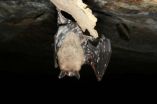(Press-News.org) A team of wildlife experts led by UC Davis called today for a national fight against a new fungus that has killed more than 1 million bats in the eastern United States and is spreading fast throughout North America.
"If we lose bats, we lose keystone species in some communities, predators that consume enormous numbers of insects, and beautiful wildlife species that are important parts of North America's biodiversity," said Janet Foley, a UC Davis professor of veterinary medicine at the Center for Vectorborne Diseases.
Foley and her co-authors' call to action appears today online in the Early View section of the journal Conservation Biology.
Bats are essential members of natural ecosystems, hunting insects, pollinating plants and scattering seeds, Foley said. "Bats do the jobs at night that birds do during the day. But because they are most active in darkness, few people are aware of how many bats live around us and how valuable they are."
The new fungal disease has been named "white-nose syndrome." Scientists think the fungus, which normally lives in soil, somehow traveled to cave walls where bats hibernate in winter and began infecting the animals' facial skin and wing membranes.
Sick bats appear to be coated with frost. They fly more than normal, which uses up fat reserves, and also lose water at a faster rate than normal. Disoriented, they move to exposed places, such as cave entrances.
Eventually, they starve, freeze or die of dehydration.
The first infected bats were found by a cave explorer near Albany, N.Y., in February 2006. Since then, infected bats have been found northward to Ontario and Quebec in Canada, south to Tennessee and west to Oklahoma. The authors write that they expect white-nose syndrome to cross the Rocky Mountains and enter California in the next several years.
There are 23 species of bats in California that hibernate in caves, and so are vulnerable to white-nose syndrome.
Foley said the fungus does not appear to be a threat to people or animals other than bats.
The National Wildlife Health Center, a program of the U.S. Geological Survey, identified the white-nose fungus, Geomyces destructans, in 2007.
"In the three years since its discovery, white-nose syndrome has changed the focus of bat conservation in North America," said Foley. "A national response is required, and our epidemiological roadmap is designed to help emerging state and national plans to combat white-nose syndrome across the United States."
Foley and her collaborators developed their recommendations at a workshop in Colorado in August funded by the National Park Service.
The authors' recommendations include: an outbreak investigation network that would establish a standard diagnosis and case definitions; bat population monitoring; and improved public awareness of the problem. "Scientists, policy makers and members of the public will all have a voice in the coming debate over the best course of action," Foley said. They also call for further studies of chemical and biological agents known to kill the fungus but not yet proven safe for bats, as well as study of treatments for similar diseases.
INFORMATION:
Foley's co-authors are: Deana Clifford, a research associate at the UC Davis Wildlife Health Center and associate wildlife veterinarian at the California Department of Fish and Game's Wildlife Investigations Lab in Sacramento; Kevin Castle, a wildlife veterinarian at the National Park Service's Biological Resource Management Division in Fort Collins, Colo.; Paul Cryan, a research biologist at the U.S. Geological Survey in Fort Collins; and Richard Ostfeld, a senior scientist at the Cary Institute of Ecosystems Studies in Millbrook, N.Y.
About UC Davis
For more than 100 years, UC Davis has engaged in teaching, research and public service that matter to California and transform the world. Located close to the state capital, UC Davis has more than 32,000 students, more than 2,500 faculty and more than 21,000 staff, an annual research budget that exceeds $678 million, a comprehensive health system and 13 specialized research centers. The university offers interdisciplinary graduate study and more than 100 undergraduate majors in four colleges — Agricultural and Environmental Sciences, Biological Sciences, Engineering, and Letters and Science. It also houses six professional schools — Education, Law, Management, Medicine, Veterinary Medicine and the Betty Irene Moore School of Nursing.
Links:
Full text of study, "Investigating and Managing the Rapid Emergence of White Nose Syndrome, a Novel, Fatal Infectious Disease of Hibernating Bats": http://onlinelibrary.wiley.com/journal/10.1111/%28ISSN%291523-1739/earlyview
Janet Foley: http://www.vetmed.ucdavis.edu/cvec/foley_bio.html
U.S. Fish and Wildlife Service: http://www.fws.gov/whitenosesyndrome/
Bat Conservation International: http://www.batcon.org/index.php/what-we-do/white-nose-syndrome.html
Media contacts:
Janet Foley, UC Davis School of Veterinary Medicine, (530) 754-9740, jefoley@ucdavis.edu.
Sylvia Wright, UC Davis News Service, (530) 752-7704, swright@ucdavis.edu
Death in the bat caves: UC Davis experts call for action against fast-moving disease
New fungus has killed 1 million bats in eastern US; heading west
2011-02-03
ELSE PRESS RELEASES FROM THIS DATE:
Synthetic materials that behave like mollusk shells
2011-02-03
Nacre, commonly known as mother-of-pearl, is the iridescent material lining many mollusk shells. It is part of a two-layer armor system that protects the animal from predators. The brittle outer layer of the shell absorbs the initial impact, but is prone to cracking. To prevent these cracks from catastrophically propagating through the shell to the animal itself, the nacreous layer is surprisingly strong and tough, with outstanding crack arresting properties. Thus it acts as a lining to maintain the integrity of the shell in the event of cracking of the outer layer.
"What ...
GSA Bulletin highlights: New research posted Jan. 21-28
2011-02-03
Boulder, CO, USA - GSA Bulletin is now regularly posting pre-issue publication content -- finalized papers that have not been assigned to an issue but are not under embargo. GSA invites you to sign up for e-alerts and/or RSS feeds to have access to new journal content the minute it is posted online. Go to http://www.gsapubs.org/cgi/alerts and enter your e-mail address to manage your subscriptions.
Faulted terrace risers place new constraints on the late Quaternary slip rate for the central Altyn Tagh fault, northwest Tibet
Ryan D. Gold et al., Dept. of Geology, ...
Migraine surgery offers good long-term outcomes
2011-02-03
Surgery to "deactivate" migraine headaches produces lasting good results, with nearly 90 percent of patients having at least partial relief at five years' follow-up, reports a study in the February issue of Plastic and Reconstructive Surgery®, the official medical journal of the American Society of Plastic Surgeons (ASPS).
In about 30 percent of patients, migraine headaches were completely eliminated after surgery, according to the new study, led by Dr. Bahman Guyuron, chairman of Plastic and Reconstructive Surgery at University Hospitals Case Medical Center and Case ...
Researchers lead search for better drug-addiction treatments
2011-02-03
DALLAS – Feb. 3, 2011 – UT Southwestern Medical Center psychiatry researchers are leading the Texas arm of a national network that conducts clinical trials aimed at finding effective treatments for drug addiction.
More than 100 community treatment providers and academic medical centers throughout the country are funded in part through the National Institute on Drug Abuse's Clinical Trials Network (CTN). The Texas component includes partnerships between academic and community treatment providers in Dallas, El Paso, Austin and Houston. It is led by Dr. Madhukar Trivedi, ...
Earth's life support systems discussed in an open-access special issue
2011-02-03
In the search for life on Mars or any planet, there is much more than the presence of carbon and oxygen to consider. Using Earth's biogeochemical cycles as a reference point, elements like nitrogen, iron and sulfur are just as important for supporting life. As explored in studies published in February's open-access Special Issue of Frontiers in Ecology and the Environment, the most basic elements work together to support an extraordinary diversity of life.
Cycles of carbon, nitrogen and phosphorous are intertwined and rely on organisms just as much as organisms rely ...
GOES-13 Satellite sees Groundhog's Day on ice
2011-02-03
Punxsutawney Phil predicted that spring will come on time, and NASA satellite data suggests that residents in more than one-third of the U.S. are now anxious for the prediction to come true.
A massive winter storm touched 30 states over the last couple of days, including Phil's home at Gobbler's Knob in Punxsutawney, Pa. where rain mixed with sleet and freezing rain this morning before it changed to snow as part of that system. Phil's town is about 80 miles northeast of Pittsburgh. Looking at the satellite data, it's more than likely that the cloud cover and wet weather ...
UC San Diego engineers play role in warehouse fire safety
2011-02-03
VIDEO:
UCSD engineers are studying how cardboard boxes burn in an effort to help predict how warehouse fires spread and to prevent severe damage and loss of lives.
Click here for more information.
Imagine this: Firefighters enter a several football field-sized, 60-foot high, pitch-black warehouse and they can't see inside—they don't know if there is an inferno or a small fire with a lot of smoke. It's a very dangerous situation, making choices hard. Engineers at UC San ...
Experiment reaches biology milestone with hard X-ray laser
2011-02-03
TEMPE, Ariz. – Unraveling the molecular basis of life is an age-old quest of humanity. A breakthrough towards this goal was reported in a pair of studies published Feb. 3 in the scientific journal Nature, detailing a new method developed to determine structures of biomolecules based on diffraction from protein nanocrystals that are so small that they are not even visible under the microscope. A tiny aerojet nozzle provides a fully hydrated constant stream of nanocrystals, both supplied from an interdisciplinary research team at Arizona State University.
These developments ...
NASA Aqua Satellite sees powerful Cyclone Yasi make landfall in Queensland, Australia
2011-02-03
NASA's Aqua satellite captured visible and infrared imagery of powerful Cyclone Yasi as it was making landfall in Queensland. The center of the monster cyclone Yasi made landfall on Australia's northeastern coast early Thursday (Australia local time) bringing heavy rainfall, severe winds and storm surge.
On Feb. 2 at 03:35 UTC/1:35 p.m. Australia local time, the Moderate Resolution Imaging Spectroradiometer (MODIS) instrument on NASA's Aqua satellite captured a visible image of Cyclone Yasi before it made landfall in Queensland, Australia. The eye of the cyclone was ...
Oysters at risk: Gastronomes' delight disappearing globally
2011-02-03
A new, wide-ranging survey that compares the past and present condition of oyster reefs around the globe finds that more than 90 percent of former reefs have been lost in most of the "bays" and ecoregions where the prized molluscs were formerly abundant. In many places, such as the Wadden Sea in Europe and Narragansett Bay, oysters are rated "functionally extinct," with fewer than 1 percent of former reefs persisting. The declines are in most cases a result of over-harvesting of wild populations and disease, often exacerbated by the introduction of non-native species.
Oysters ...
LAST 30 PRESS RELEASES:
iPS cells from dish to freezer and back
Deep neural networks enable accurate pricing of American options under stochastic volatility
Collective risk resonance in Chinese stock sectors uncovered through higher-order network analysis
Does CPU impact systemic risk contributions of Chinese sectors? Evidence from mixed frequency methods with asymmetric tail long memory
General intelligence framework to predict virus adaptation based on a genome language model
Antibiotic resistance is ancient, ecological, and deeply connected to human activity, new review shows
Vapes, pouches, heated tobacco, shisha, cigarettes: nicotine in all forms is toxic to the heart and blood vessels
From powder to planet: University of Modena engineers forge a low-carbon future for advanced metal manufacturing
Super strain-resistant superconductors
Pre-school health programme does not improve children’s diet or physical activity, prompting call for policy changes, study finds
Autumn clock change linked to reduction in certain health conditions
AI images of doctors can exaggerate and reinforce existing stereotypes
Where medicine meets melody – how lullabies help babies and parents in intensive care
We may never be able to tell if AI becomes conscious, argues philosopher
AI video translation shows promise but humans still hold the edge
Deep ocean earthquakes drive Southern Ocean’s massive phytoplankton blooms, study finds
Without campus leftovers to pick through, the beaks of this bird changed shape during the pandemic
High-dose antibiotic does not reduce mortality in tuberculous meningitis
How many insects fly in the sky above the USA?
Could cheese protect your brain health?
Who faces more difficulty recovering from stroke?
Colliding galaxies create the brightest, fastest growing black holes at their center
New BrainHealth research reveals tradeoffs on sleep with cannabis use for chronic pain
Aging-US now on ResearchGate, enhancing visibility for authors and readers
'Molecular glue' stabilizes protein that inhibits development of non-small cell lung cancer
Mount Sinai Health System is recognized in 2025 Chime Digital Health Most Wired survey
From prey to predator: How carnivores spread beneficial fungi
Menopause symptoms may be frequent and have negative effects, according to female endurance athletes
US Congressmembers’ responses on X to mass shooting events differ along party lines
KAIST-UEL team develops “origami” airless wheel to explore lunar caves
[Press-News.org] Death in the bat caves: UC Davis experts call for action against fast-moving diseaseNew fungus has killed 1 million bats in eastern US; heading west




